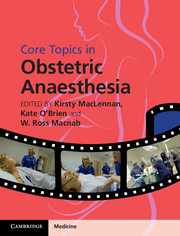Book contents
- Frontmatter
- Contents
- List of contributors
- Preface
- Section 1 Basic science, epidemiology and service organization
- 1 Physiology of pregnancy
- 2 Placental physiology
- 3 Pharmacology relevant to pregnancy
- 4 Maternal morbidity and mortality
- Section 2 Obstetric aspects
- Section 3 Provision of anaesthesia
- Section 4 Medical conditions in pregnancy
- Section 5 Postpartum complications and obstetric emergencies
- Section 6 Service organization
- Index
- Plate section
- References
3 - Pharmacology relevant to pregnancy
from Section 1 - Basic science, epidemiology and service organization
Published online by Cambridge University Press: 05 December 2015
- Frontmatter
- Contents
- List of contributors
- Preface
- Section 1 Basic science, epidemiology and service organization
- 1 Physiology of pregnancy
- 2 Placental physiology
- 3 Pharmacology relevant to pregnancy
- 4 Maternal morbidity and mortality
- Section 2 Obstetric aspects
- Section 3 Provision of anaesthesia
- Section 4 Medical conditions in pregnancy
- Section 5 Postpartum complications and obstetric emergencies
- Section 6 Service organization
- Index
- Plate section
- References
Summary
There are specific issues with regard to therapeutics and pharmacology in the expectant mother and during the postpartum period. There are general changes in the pharmacokinetics and pharmacodynamics, considerations relating to the placenta, potential effects on the fetus and impacts on breastfeeding.
Pharmacokinetics
Bioavailability
The absorption of a drug is the method by which it moves into the body and into the circulating blood, and is characterized as the bioavailability. This can be via a wide range of routes, those used most commonly by the anaesthetist are intravenous (IV), inhalational, epidural, intrathecal, oral, intramuscular (IM), sublingual, intranasal, rectal and transdermal. Despite the enhanced cardiac output in pregnancy, the absorption of drugs is minimally affected, but pregnancy-induced emesis may reduce the bioavailability of orally administered drugs. The increased minute ventilation associated with pregnancy can speed the onset and offset of inhalational agents.
Volume of distribution (VD)
The distribution of a drug throughout the body is dependent on various factors: physicochemical characteristics of the drug (molecular size, lipid solubility, ionization and protein binding), regional blood flow and any cellular transport mechanisms. The volume of distribution (VD) can be greatly affected by pregnancy. Increases in circulating blood volume and total body water provide a larger VD for most drugs. Pregnancy alters the plasma protein profile, potentially changing binding characteristics and the fraction of free drug available for action. Increased cardiac output will speed the distribution of drugs.
Placental transfer
The fetus is also, in effect, an additional compartment into which drugs may distribute. The factors affecting the extent to which drugs cross the placenta into fetal circulation are similar to those for any phospholipid membrane bilayer. Placental transfer will be facilitated for more lipid-soluble drugs, compared to hydrophilic polar or ionized molecules. Likewise, the greater the proportion that is free drug or in the unbound state, the faster it will equilibrate. The extents to which the drug is ionized and protein bound may be different in mother and fetus because of the reduced pH in the fetus, and this may impact on the effective concentration gradients. This situation may change or be exacerbated by labour, during which maternal and fetal acidoses may develop.
Metabolism
Metabolism of drugs is largely unaffected by normal pregnancy. It is possible that the pathological state of HELLP (Haemolysis, Elevated Liver enzymes, Low Platelets) syndrome may impair liver function and thus the metabolism of drugs.
- Type
- Chapter
- Information
- Core Topics in Obstetric Anaesthesia , pp. 13 - 23Publisher: Cambridge University PressPrint publication year: 2015



